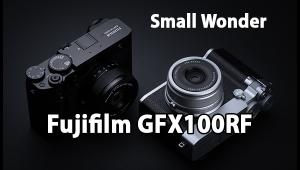Fujifilm X-E1 Mirrorless Camera Review
The X-E1 is the second mirrorless system camera made by Fujifilm. In contrast to the X-Pro1, it has an electronic viewfinder with ultrahigh resolution (2.3 million RGB dots) instead of the X-Pro1’s hybrid viewfinder (combination of optical viewfinder and electronic viewfinder).





This new viewfinder is one reason for the compact design of the X-E1, which is a lot smaller than the X-Pro1. The 2.8” LCD screen on the back is a bit small for a high-priced camera and offers a resolution of 460,000 RGB dots. (Most SLRs and system cameras offer 3” monitors with at least 614,000 or 920,000 RGB dots.) The camera has a sensor that switches automatically between LCD screen and EVF when the photographer looks into the electronic viewfinder.
The X-E1 has the same 16MP sensor as the X-Pro1 and uses the company’s APS-C X-Trans CMOS sensor with a modified RGB filter pattern rather than the classic Bayer pattern. Due to this new sensor the X-E1 is able to work without a low-pass filter, which helps create very sharp and crisp images, although we did notice some aliasing when images were highly enlarged.
The X-E1 doesn’t offer a built-in stabilizer system, but the 18-55mm lens used for this test has an optical stabilizer system, which allowed us to shoot images handheld with shutter speeds of 1/8 sec to 1/10 sec (at the max tele setting of the lens) without motion blur.
The X-E1 features the same operational concept as the X-Pro1. Set up of aperture and shutter speed is done manually with the lens ring and a setup dial on the top—comparable to the concept of a classic analog viewfinder camera. By using one of the setup rings the user can switch between Av and Tv exposure modes and utilize full manual control of exposure settings. The camera offers numerous function buttons for fast set up of all parameters. A user-defined function button on the top and a Q(uick) menu button on the back allows for direct access to the most important camera setups. A dial located on the back and controlled by the thumb of the right hand allows users to change settings quickly and efficiently.

Image Quality
Color: The Fujifilm X-E1 delivers natural-looking colors with only a slightly high saturation (106.7 percent). The automatic white balance system placed nearly all gray patterns exactly in the center of the result chart; only the brightest areas show a shift into yellow areas. The precise white balance setting is also noticeable in the model shot and the standard test box shot.
The differentiation of colors is good. Nevertheless, the structure of the red fabric of the model’s T-shirt could be bit more differentiated. Skin tones are fine, but the brighter skin tone areas show a slightly high magenta rate.

Sharpness: The images shot with the X-E1 have extremely high resolution and high sharpness. The test chart was reproduced with the nominal resolution of the sensor (3222 of 3264 lines per picture height) without exaggerated sharpness filtering. This is also a result of the lack of a low-pass filter over the APS-C X-Trans CMOS sensor. The very sharp images, however, sometimes results in very fine structures showing an aliasing effect. We noticed that in the hair in the middle of the model’s forehead, for example. But these effects are only noticeable in very highly enlarged zoom modes or very big enlargements.
Noise: Noise results of the X-E1 are very good. The luminance noise factor is very good up until ISO 6400 mode, which is the maximum ISO speed setting without resorting to the high or “push” ISO setting. The same applies to color noise: clearly visible color clouds only appear in images taken with the ISO 6400 setting.

The dynamic range results are very good: the camera achieves a maximum of 11.6 f/stops, which is a very good result for a camera with an APS-C-sized image sensor. Results are comparable to a professional SLR camera.
Scorecard
Pro
+ Very sharp images
+ Nice colors
+ Classic camera design
+ Comfortable handling
+ High-resolution EVF (2.3 million RGB dots)
+ Full HD video recording
Con
- Missing swivel monitor
- Small LCD screen on the back with low res
The Fujifilm X-E1 has a list price of $999; $1399 with the XF 18-55mm f/2.8-4 kit lens. For more information, visit www.fujifilmusa.com.
Lab results and test images by BetterNet, our TIPA-affiliated testing lab. Edited by George Schaub.
- Log in or register to post comments

















































